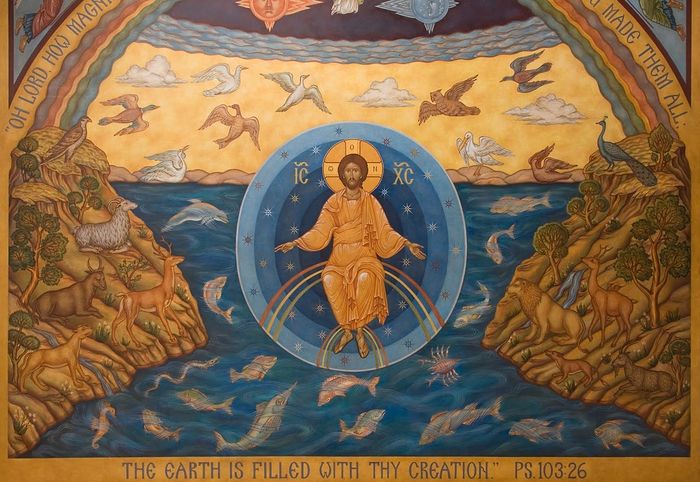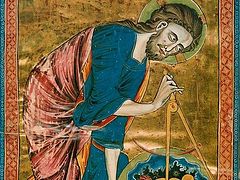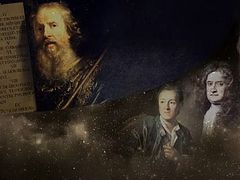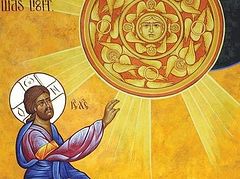Recently, I had the blessing to be asked to present informally (and unworthily!) at Fr. Felipe Balingit’s online Saturday morning Catechism class, on Blessed Seraphim Rose’s writings about the Creation in Genesis, based in the Church Fathers. Fr. Felipe’s mission work in the Philippines includes this class, which he conducts usually from Holy Trinity Seminary and Monastery in Jordanville, NY, where he is currently studying and helping to conduct worship services. The class mainly consists of dedicated Filipino Orthodox Christians and catechumens, along with others, in various time zones around the world, and usually lasts for several hours with Fr. Felipe’s teaching and answering of questions. His insights, dedication, and theirs are a great blessing to experience, glory to God!
In our discussion of the approach of the Church Fathers to Genesis, as summarized in Fr. Seraphim’s work, two participants asked the questions: “What about the dinosaurs?” and “Doesn’t the Catholic Pope now accept evolution?” These questions involved the relation of the Orthodox Church’s traditional teachings on Creation to current secular-scientific views in popular culture, which influence many in Catholic and Protestant circles, but also some Orthodox Christians. The questions also implicitly raise the issue of how Orthodox teachings, based in the Church Fathers, may differ from conservative Protestant Christian approaches to Creation as well. The whole discussion raised the issue of the importance of a patristic understanding of Creation to our faith today, and the unworthy reflection below is based on the conversation.
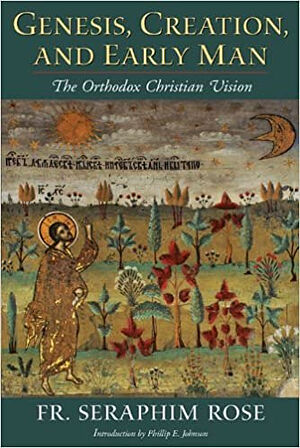 The cover of the second edition (2011) of the compilation of Blessed Seraphim’s work on Creation, based in the Church Fathers Fr. Seraphim (+1982), an American convert to Orthodoxy, went from a dissolute life as an intellectual in America’s beatnik culture in San Francisco to being one of the most influential English-language teachers and writers on Orthodox ascetic tradition, through the guidance of St. John of Shanghai and San Francisco. He is often called “Blessed Seraphim” by many today, in pious belief in his sanctity, although he has not been recognized yet formally as a Saint in the Orthodox Church. A monastic who became a priest in the Russian Orthodox Church Outside of Russia, he considered the patristic understanding of the account of Creation to be an indispensable foundation of Orthodox Christian faith. He found that secular materialistic interpretations of Creation undergird the current age’s ethos of radical individual autonomy, tending toward nihilism across all political and cultural views in the modern “global West,” as he experienced himself before his conversion. He discerned these attitudes were contributing to an amorphous global “spirituality,” in the spirit of Anti-Christ, denying the Incarnation of Jesus Christ and by extension the historical aspects of the Incarnation and the founding of the Church, with her roots also in the Old Testament. This is why so much of his work in apologetic theology is focused on the issue of Creation, as seen in the long compilation Genesis, Creation, and Early Man by Abbot Damascene Christiansen, who was brought into the Church by Blessed Seraphim and now heads the monastery that his spiritual mentor co-founded, St. Herman of Alaska Monastery in Platina, California, which is now a Serbian Orthodox Christian monastic community. The book, published originally in 2000, and then in its second edition in 2011, is currently out of print, although a new edition reportedly is in the works.
The cover of the second edition (2011) of the compilation of Blessed Seraphim’s work on Creation, based in the Church Fathers Fr. Seraphim (+1982), an American convert to Orthodoxy, went from a dissolute life as an intellectual in America’s beatnik culture in San Francisco to being one of the most influential English-language teachers and writers on Orthodox ascetic tradition, through the guidance of St. John of Shanghai and San Francisco. He is often called “Blessed Seraphim” by many today, in pious belief in his sanctity, although he has not been recognized yet formally as a Saint in the Orthodox Church. A monastic who became a priest in the Russian Orthodox Church Outside of Russia, he considered the patristic understanding of the account of Creation to be an indispensable foundation of Orthodox Christian faith. He found that secular materialistic interpretations of Creation undergird the current age’s ethos of radical individual autonomy, tending toward nihilism across all political and cultural views in the modern “global West,” as he experienced himself before his conversion. He discerned these attitudes were contributing to an amorphous global “spirituality,” in the spirit of Anti-Christ, denying the Incarnation of Jesus Christ and by extension the historical aspects of the Incarnation and the founding of the Church, with her roots also in the Old Testament. This is why so much of his work in apologetic theology is focused on the issue of Creation, as seen in the long compilation Genesis, Creation, and Early Man by Abbot Damascene Christiansen, who was brought into the Church by Blessed Seraphim and now heads the monastery that his spiritual mentor co-founded, St. Herman of Alaska Monastery in Platina, California, which is now a Serbian Orthodox Christian monastic community. The book, published originally in 2000, and then in its second edition in 2011, is currently out of print, although a new edition reportedly is in the works.
The patristic teaching on Creation does not fit comfortably with today’s efforts in liberal religious circles to synthesize secular accounts of evolution and “non-intelligent design” with “theistic evolution,” let alone a Deistic view. At the same time, Father Seraphim indicated that Protestant-inspired approaches of “creationism” and “intelligent design” sometimes proceed in an overly rationalistic way to try to understand the mechanics of the biblical Six Days of Creation and of human life before the Fall, which the Church Fathers regarded as mysteries from an Orthodox standpoint.
The Current Controversy
Before highlighting a few main points of Fr. Seraphim’s work on Creation in relation to the Church Fathers, with links for further study, it is perhaps worthwhile to consider how these issues of Creation in secular culture became the basis of anti-Christian polemic. Indeed, Charles Darwin’s nineteenth-century Theory of Evolution, together with the work of Karl Marx in economics and of Sigmund Freud in psychology, are often revered as three foundational pillars of modern atheistic materialism by ideologues today.
Interview of atheist evolutionary biologist Richard Dawkins by conservative Jewish commentator Ben Stein, in the film Expelled (2008), illustrating modern secular debate on Creation.
Here’s one example I remember vividly. In 2010, the African-American neurosurgeon Ben Carson was announced as Commencement Speaker at my university campus. Dr. Carson (who then was not in politics), in accord with his Seventh-Day Adventist faith, had advocated for “intelligent design” views, which argue that there is scientific evidence for an intelligent pattern to life in the university, as promoted by the Discovery Institute. (Father Seraphim had pointed to some issues raised by the early “intelligent design” movement in his teaching and writing in the 1970s and 1980s, although always basing his views in that of the Church Fathers, as noted in the next section.) Carson’s visit to campus became controversial. Protest erupted even though Dr. Carson’s speech was about lessons from his own life, growing up in a single-parent home in public housing, and rising to the top of the medical profession, and not about “intelligent design.” A number of faculty called for cancelling his visit, and then for a boycott of it, by turning their backs on him at Commencement. The irony of mainly white faculty at an upscale university turning their backs on an African-American speaker because of his religious beliefs, all while professing diversity and social justice, was not lost on many.
The controversy also set off a long thread of emails across weeks among faculty, with one Neuroscience Professor opining that “religion is a virus that should be exterminated.” The university Communications officer in an effort to tamp down the controversy, concerned partly about a potential negative effect on conservative alumni and area residents, organized a forum on “faith and reason/reason and faith,” at which some faculty members noticeably laughed when I mentioned that Orthodox Christians regard Moses’ account of Creation as a divine prophecy of the past. So much, again, for diversity and inclusion in much of American higher education, when it involves views different from dominant secular ideology. (Meanwhile scientists on our campus continued to celebrate “Darwin Day” prominently on his birthday, while references to Christmas generally disappeared across campus in the twenty-first century, with directives to avoid using the term in greetings and putting up Christmas decorations in academic buildings, apart from the Chapel at our originally Baptist university.)
The conservative Jewish writer Ben Stein’s earlier 2008 documentary Expelled: No Intelligence Allowed (see the video clip above) addressed this secular intolerance, as well, which had been exacerbated by the rise of the circle of “new atheist” intellectual-celebrities led by the British evolutionary biologist Richard Dawkins. Many of the anxieties, and hate, brought out by the visit by Dr. Carson to our campus, centered around current controversy over science curriculum in U.S. public schools. Should or would Charles Darwin’s Theory of Evolution be presented as one hypothesis to be discussed in relation to “intelligent design” views in science classes in some school districts? Generally “intelligent design” ended up excluded from most if not all American public school curricula.
But issues about the gaps in evidence for Darwin’s theory have continued to percolate in discussion and controversy. Recently, the conservative Jewish scholar David Gelernter, an eminent professor of computer science at Yale, while explicitly not embracing “intelligent design” theory, summarized the criticisms of Darwin’s theory to indicate why he no longer accepted it. In an article in the Spring 2019 issue of The Claremont Review of Books, which caused a stir in secularized conservative circles in America, Gelernter wrote at length on his reasons for “Giving Up Darwin.” It was subtitled online “A Fond Farewell to a Brilliant and Beautiful Theory.”
The opening paragraph sums up Prof. Gelernter’s concern:
Darwinian evolution is a brilliant and beautiful scientific theory. Once it was a daring guess. Today it is basic to the credo that defines the modern worldview. Accepting the theory as settled truth—no more subject to debate than the earth being round or the sky blue or force being mass times acceleration—certifies that you are devoutly orthodox in your scientific views; which in turn is an essential first step towards being taken seriously in any part of modern intellectual life. But what if Darwin was wrong?
Dr. Stephen Meyer, interviewed recently about his work on “intelligent design,” by Evangelical Protestant media personality Eric Metaxas
Prof. Gelernter in his article goes on to summarize why Darwin’s nineteenth-century theory was wrong from the perspective of twenty-first-century science:
- Darwin’s theory can explain small adjustments to local circumstances by an organism, but cannot explain what the early naturalist proclaimed as The Origin of Species.
- The great explosion of life seen by scientists today in the geological record of the “Cambrian explosion” does not fit Darwin’s theory of an “upward-branching” structure of gradually unfolding life.
- Darwin lacked access to developments in molecular biology since his time. Neo-Darwinism more recently sought to incorporate the latter field into an explanation of Darwin’s theory. However, evidence for generating a new shape of protein to generate new forms of life is lacking. Random mutation plus natural selection seem insufficient to explain any creation of new protein shapes.
Prof. Gelernter noted, under the subheading “A Bad Bet”:
The odds against blind Darwinian chance having turned up even one mutation with the potential to push evolution forward are 10-to-the-fortieth-power times one/tenth- to-the-seventh-seventh power — 10-to-the-fortieth power tries, where your odds of success each time are 1 in 10 to the seventh-seventh power — which equals 1 in 10-to-the-thirty-seventh power. In practical terms, those odds are still zero. Zero odds of producing a single promising mutation in the whole history of life. Darwin loses…. Neo-Darwinianism says that nature simply rolls the dice, and if something useful emerges, great. Otherwise, try again. But useful sequences are so gigantically rare that this answer simply won’t work.
4. For Darwin’s theory to hold true at a mega-level, involving the formation of new species (as opposed to a micro one involving adaptations within a species), would require gene mutations for which evidence, too, is lacking, Prof. Gelernter wrote:
Evidently there are a total of no examples in the literature of mutations that affect early development and the body plan as a whole and are not fatal.
Prof. Gelernter’s essay was in effect a review of what he called three “essential” books on problems with Darwin’s theory, which also discuss the case for “intelligent design” as the authors are all affiliated with the Discovery Institute:
—Darwin’s Doubt (2013) by geophysicist and philosopher of science Stephen Meyer;
—The Deniable Darwin and Other Essays (2009) by philosopher and mathematician David Berlinski;
—Debating Darwin’s Doubt (2015) edited by Orthodox Jewish writer David Klinghoffer, an anthology of articles engaging in debate about Meyer’s book.
Several years before Prof. Gelernter’s article, the scholar often regarded as the leading atheist-philosopher in the U.S., Prof. Thomas Nagel, shocked many secular academics with his 2012 book Mind and Cosmos: Why the Materialist Neo-Darwinian Conception of Nature is Almost Certainly Wrong. Prof. Nagel crowned a career of criticizing reductionist materialistic views of consciousness by conceding that that the “intelligent design” movement effectively showed up flaws in Neo-Darwinism, which could not account for the emergence of consciousness. While not embracing “intelligent design,” he wrote that it differed from “creation science” (a more explicitly religious conservative Protestant effort to “prove” biblical accounts scientifically true), by contributing valid scientific critiques of Neo-Darwinism. For this, Nagel became something of an intellectual pariah to many in secular academia.
The Church Fathers, Scripture, and the Revelation to Moses
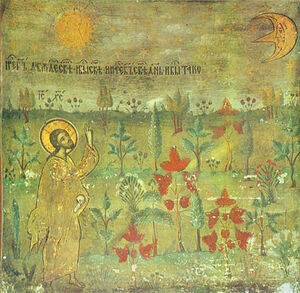 Icon of Christ Creating the Plants, 15th century, from a fresco in the Sucevita Monastery in Romania. While the main 1,144-page book of Fr. Seraphim’s writings and compilation of patristic quotes on Creation is currently out of print as noted above, there is an article summarizing its points by Abbot Damascene that is available online, and also a short book of St. Symeon the New Theologian’s writings on the biblical Creation account, translated by Father Seraphim, which is still in print and which he considered to be essential patristic reading on the topic.
Icon of Christ Creating the Plants, 15th century, from a fresco in the Sucevita Monastery in Romania. While the main 1,144-page book of Fr. Seraphim’s writings and compilation of patristic quotes on Creation is currently out of print as noted above, there is an article summarizing its points by Abbot Damascene that is available online, and also a short book of St. Symeon the New Theologian’s writings on the biblical Creation account, translated by Father Seraphim, which is still in print and which he considered to be essential patristic reading on the topic.
The article by Abbot Damascene is based on a talk that he gave in 2008 at the International Nativity Educational Readings of the Moscow Patriarchate, in the section “The Orthodox Interpretation of the Creation of the World,” at the Moscow State University of Railway Engineering. Support for that session came from a project in Russia aimed at encouraging a traditional Orthodox version of Creation, which is referenced in the issue of the Orthodox Word that published the article. His presentation in Moscow in turn was based on a paper that he gave in 2007 at the “Conference on Orthodoxy and the Natural Environment” at St. Nicholas Ranch in California. Some papers from the latter conference, together with additional contributions (including one on literature and the environment by your unworthy blogger) were included in the edited collection Toward an Ecology of Transfiguration: Orthodox Christian Perspectives on Environment, Nature, and Creation (2013), which was endorsed by the Patriarch of Constantinople, Bartholomew. But as I found out later, Abbot Damascene’s paper had been left out of the collection. Perhaps this was because it was not in accord with another paper in the collection favorable towards adaptations of Darwin’s theory, or with likely perspectives of reviewers through the academic publisher, a liberal Catholic university press. At any rate, Abbot Damascene’s article is included as an appendix to the second edition of his collection of Fr. Seraphim’s writings on Creation.
Offering a patristic vision, Abbot Damascene summarizes Blessed Seraphim’s commentary on Genesis from the Church Fathers in several main points:
- Man’s condition before the Fall involved creation in grace, participating in the Divine Energies but not Essence, with the potential for deification. Adam and Eve were “conditionally immortal.” Their bodily existence did not have according to the Fathers the fallen coarser aspects of physical corporeality today. Human beings before the Fall did not experience “irrational desire” for pleasures, finding their pleasure in God. Direct relation with “the most simple and imageless essences of created beings” was possible, without the mediation of imagination, according to St. Maximus the Confessor.
- Originally the Cosmos did not involve carnivority, or perishable and obnoxious fruits and plants or creatures. Animals were given plants to eat before the Fall. Decay and death were not present. As Abbot Damascene summarizes from patristic commentaries on Genesis, “the fossil record must be placed, historically, after the fall of man.”
- The Fall, as St. Gregory of Nyssa indicated, involved the mind like a mirror receiving the image of formless matter instead of reflecting God as before. In effect, the result was an objectification of self and of the world and others, a “stripping of grace” or spiritual death, an inclination toward sin in fallen human nature. This made man subject to physical death, in the separation of soul from body. Sexual passion and procreation also emerged after the Fall. If Adam and Eve had not fallen, God would have provided other means for procreation, the Fathers wrote.
- The Fathers indicate eschatological connections between man’s pre-fallen state, and the state of man and the cosmos to come with Christ’s Second Coming and the general resurrection. There will be both restoration to Paradise and even further fulfillment in deification then, except for those who have cut themselves off from grace because of wicked selfish lives on earth. The latter will experience God’s love then as a burning fire because of not learning to participate in His love during their embodied life in the here-and-now on earth. That involves the mystery of the freedom that God has granted to men. That inextricably relates to the redemption of human beings by Jesus Christ, as seen in the salvation of the Wise Thief on the Cross, and of the rescue of Adam and Eve from Hades on Holy Saturday. It also involves the Church’s sense of theodicy, that suffering and death are not to God’s blame (as some such as Ivan Karamazov blasphemously would aver) but rather are signs of God’s mercy, leading man towards redemption in deification through Jesus Christ, in the divine energies of the Holy Spirit.
 Fr. Seraphim Rose translated these seven homilies by St. Symeon the New Theologian, which he considered to be essential for understanding patristic Christian cosmology. As Fr. Seraphim noted in his writings on Creation, the mystery of the Six Days and of man’s state before the Fall (together with that of the Cosmos) may be glimpsed through revelation, but can never be plumbed in any full sense by human reason. Indeed, the Fall brought with it changes in dimensions of time and space, which place a veil between us and a full understanding of our origins outside of what is revealed to us through the Church, and what holy saints have been able to experience. That which is natural in Orthodox Christianity is not our biological state, currently in a fallen world, but the pre-fallen state of man and the cosmos, as it is to be fulfilled in the life of the age or world to come. “The resurrection is the restoration of [human] nature,” as Abbot Damascene quotes from St. Nicholas Cabasilas. He also quotes from Vladimir Lossky, a twentieth-century Orthodox writer on theology: “Nature and grace do not exist side by side, rather there is a mutual interpenetration of one another, the one exists for the other.”
Fr. Seraphim Rose translated these seven homilies by St. Symeon the New Theologian, which he considered to be essential for understanding patristic Christian cosmology. As Fr. Seraphim noted in his writings on Creation, the mystery of the Six Days and of man’s state before the Fall (together with that of the Cosmos) may be glimpsed through revelation, but can never be plumbed in any full sense by human reason. Indeed, the Fall brought with it changes in dimensions of time and space, which place a veil between us and a full understanding of our origins outside of what is revealed to us through the Church, and what holy saints have been able to experience. That which is natural in Orthodox Christianity is not our biological state, currently in a fallen world, but the pre-fallen state of man and the cosmos, as it is to be fulfilled in the life of the age or world to come. “The resurrection is the restoration of [human] nature,” as Abbot Damascene quotes from St. Nicholas Cabasilas. He also quotes from Vladimir Lossky, a twentieth-century Orthodox writer on theology: “Nature and grace do not exist side by side, rather there is a mutual interpenetration of one another, the one exists for the other.”
Thus, also, both symbolic and literal interpretations of the Genesis account are interwoven in patristic commentaries, much as how iconography can reflect a spiritual presence in a physical reality, in a living embodied symbolism, as is the case even more with the liturgical mysteries of the Church and in the ascetic struggle toward theosis in hesychasm. Thus the Byzantine calendar, in use in Russia until the time of Peter the Great, still referenced on Mount Athos and among traditional Orthodox Christians, dates the year of this reflection as 7528 from the Creation of the world, based on calculations from Scripture in Church Tradition (this parallels the Jewish calendar to this day as well, although with a different calculation). This shapes the sense of sacred time, alongside the chronology linking all the trans-generational genealogies of the Bible, culminating in the Incarnation followed by Pentecost, through which in the Church all men potentially become descendants of the Old Testament Church Prophets fulfilled in the New Testament. All also are seen as descendants of Adam and Eve, and related genealogically to God through the Incarnation of Jesus Christ. Thus, Fr. Seraphim’s writings also note the consensus of the Church Fathers that Creation indeed occurred over the sequence of seven days described in Genesis, with an historical basis.
The Church views Genesis as a revelation from God to Moses of the primordial past. Our Lord Jesus Christ Himself referenced Adam and Eve, and their son Abel, as actual persons. The teachings of the Church indicate that although the Most Holy Trinity is the Creator God, our Lord Jesus Christ as the Son and the Word had a special role in Creation. Thus Orthodox iconography portrays Him engaged in the work of Creation during the Six Days, and so, too, He is referenced as the Second Adam, even as the Mother of God, His mother the Virgin Mary, is referenced as the Second Eve. The genealogical connections and historical accounts of the Old Testament Church in the formation of the first earthly Israel, fulfilled in the spiritual Israel of the Church in the New Testament, relate also to what the Church teaches were pre-Incarnational theophanies of Jesus Christ — His appearing and visions and words to the Holy Prophets, including Moses as in the revealing of His name “I Am” or “He Who Is,” and of the Ten Commandments and laws of God to the Old Testament Church of Israel, as well as earlier to Abraham with the two angels, symbolizing the Holy Trinity, at the Oak of Mamre. All these historical accounts are inter-related with the basic teachings of the Church concerning Jesus Christ and the development of His Church throughout Scripture.
Questions from the Catechism Class
Returning at the end to the Catechism class questions, what about the dinosaurs, and what about the apparent embrace of evolution by the Roman Catholic papacy (and others identifying as Christians) today?
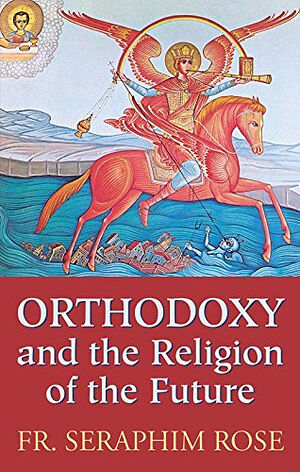 Probably Fr. Seraphim’s most popular book, warning of the nihilistic religion of the spirit of Anti-Christ, denying Christian history and the Incarnation Fr. Seraphim’s writings collected in the large book edited by Abbot Damascene suggest problems with the current science of dating geological time periods and fossils, problems that Fr. Seraphim suggested will loom larger as future science looks back on the primitiveness of the science of our own times. In the meantime, arguably the development of “new physics” and its questioning of conventional notions of dimensions of time and space, as in “quantum entanglement,” may suggest something to modern people of how a great shift or fold in dimensions of space and time altered the entire sense of reality at the time of the Fall, according to Orthodox Christian belief. This makes it particularly hard to discern in any rational way, from the standpoint of human mortals, the nature of the veil between us and the original Creation, outside the mysteries of the Church. (Some Orthodox Christians with training in science, such as Prof. Alexei Nesteruk, have written recently about overlapping borders they see between our faith and quantum physics; also, the field of ecosemiotics developed in Estonia, from which this unworthy blog takes a name, follows recent scientific developments that suggest an informational rather than atomistic basis for life, of life as meaning-making or communication — relatable to the logoi of the Logos in Orthodox Christian cosmology.)
Probably Fr. Seraphim’s most popular book, warning of the nihilistic religion of the spirit of Anti-Christ, denying Christian history and the Incarnation Fr. Seraphim’s writings collected in the large book edited by Abbot Damascene suggest problems with the current science of dating geological time periods and fossils, problems that Fr. Seraphim suggested will loom larger as future science looks back on the primitiveness of the science of our own times. In the meantime, arguably the development of “new physics” and its questioning of conventional notions of dimensions of time and space, as in “quantum entanglement,” may suggest something to modern people of how a great shift or fold in dimensions of space and time altered the entire sense of reality at the time of the Fall, according to Orthodox Christian belief. This makes it particularly hard to discern in any rational way, from the standpoint of human mortals, the nature of the veil between us and the original Creation, outside the mysteries of the Church. (Some Orthodox Christians with training in science, such as Prof. Alexei Nesteruk, have written recently about overlapping borders they see between our faith and quantum physics; also, the field of ecosemiotics developed in Estonia, from which this unworthy blog takes a name, follows recent scientific developments that suggest an informational rather than atomistic basis for life, of life as meaning-making or communication — relatable to the logoi of the Logos in Orthodox Christian cosmology.)
Regarding questions about the dinosaurs and the fossil record, as Blessed Seraphim noted, the fossil record must follow from after the Fall, with the introduction of suffering and death, after a great change in what we today call the space-time continuum, rendering notions of primordial time uncertain. Orthodox Christians are not anti-science, but live in the faith of the Church and our Fathers. Thus, while accepting efforts by scientists to understand biological life, and ways in which theories like Darwin’s may shed limited light on adaptations by organisms to their environments, we do not begin from the standpoint of materialistic and atheistic scientism and technocracy as foundational to life and faith and God’s Creation. Rather, we reject them as materialistic philosophies leading away from God, and look to the experience of life in the mysteries and empirically demonstrated truth of the Church of our Lord and His Most Holy Mother and the Holy Saints.
Those of Orthodox Christian background who have embraced secular scientistic philosophies foundationally, such as the late evolutionary biologist Prof. Theodosius Grygorovych Dobzhansky, end by accommodating them at the expense of holy Orthodox Tradition. Prof. Dobzhansky, for example, as Fr. Seraphim noted, was known for not attending Church services, for voicing heterodox attitudes of spirituality at odds with Church dogma, and for accepting practices such as cremation contrary to Church teaching. Departing from an understanding of the grounding of our faith in Orthodox cosmology enables or accompanies departures from Holy Tradition in other areas, which undoubtedly can negatively affect younger generations especially as well.
Fr. Seraphim saw such departures as inter-related with acceptance of materialistic philosophies of evolution and cosmology in the modern secular “global West.” In perhaps his most well-known work, Orthodoxy and the Religion of the Future, he advanced the connection between nihilistic cosmological views and the development of global “New Age” spirituality at odds with Orthodox Christianity. Blessed Seraphim saw this trend contributing toward the spirit of Anti-Christ abroad in the world today, a spirit that the Apostle John had defined as the denial of the Incarnation of Jesus Christ, and thus of the embodied historical experience of salvation history. This involves the full range of heresies, including Arianism (in denying the wholeness of the two natures of Christ in one Person, unconfused and undivided) and Gnosticism (which the political philosopher Eric Voegelin defined as the basis for the modern administrative state and economy, the technocracy of modern life–disembodied and run by elites with supposed access to special expert knowledge).
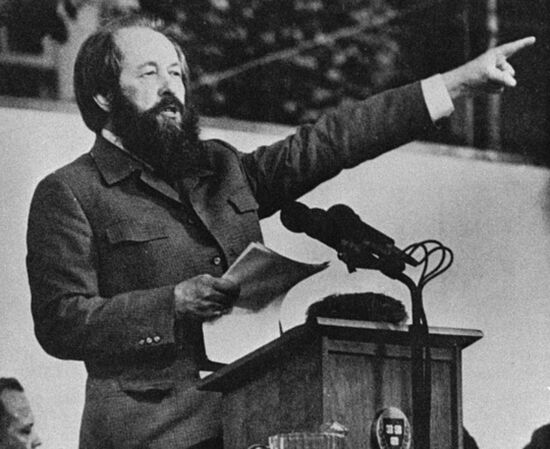 Russian Orthodox writer Alexander Solzhenitsyn. He warned the West, here at the Harvard University Commencement in 1978, of the danger of forgetting God and His Creation.
Russian Orthodox writer Alexander Solzhenitsyn. He warned the West, here at the Harvard University Commencement in 1978, of the danger of forgetting God and His Creation.
Today, transgenderism, politics based on nihilistic categories of essentialist identity, a pseudo-religious environmentalism based in “cultural Marxism,” consumerist careerism, and current forms of the so-called “prosperity gospel” and “social gospel” in American religion, all express faith in the materialistic narrative of cosmology as a kind of replacement spirituality for Orthodox Christianity, opposed to living patristic ascetic tradition. Alexander Solzhenitsyn in Book IV of The Gulag Archipelago, “The Soul and Barbed Wire,” detailed the principles behind this atheistic faith, as they contribute to totalitarianism: “Survive at any price,” “only material results matter,” and the “permanent lie” of believing that “perception is reality,” regardless of truth. These principles all express the materialistic view of the origins and underpinnings of the universe prevalent in secular modernity today, which has “forgotten God” (what Solzhenitsyn saw as the ultimate cause of totalitarianism). The Orthodox funeral refrain “Memory eternal,” featured at the end of The Brothers Karamazov, has deep meaning across generations especially today, involving trans-generational Holy Tradition, in which our saints are our truest family members in the Church, to whom we can turn to pray for us, beginning with the highest of saints, the Most Holy Mother of God Herself.
Nevertheless, there still are significant areas of overlap between the scientific understanding of the physical nature of human beings and Orthodox Christian teachings on human life and community, as opposed to false ideology of the “permanent lie” or “perception as reality” views. Transgenderism is not in accord with biological understandings of sex. Identity politics essentialize categories of race and gender not in accord with basic biological science about human beings. But adoption of atheistic materialism as the false philosophy of secular science (in what the Anglican writer C.S. Lewis critiqued as scientism and technocracy in his books The Abolition of Man and That Hideous Strength) has sparked current efforts to suppress “Creationism” and “Intelligent Design” as stalking horses or straw men for the traditional Christian understanding of Creation, generally not well understood in the West. Unlike the approaches of some conservative Protestant writers, Orthodox cosmology recognizes the mystery of the Six Days and the unfallen state of man before the Fall, in terms of how neither can be pierced by rational human analysis, but how their mysteries can be engaged by experiencing mysteries of the Church and salvation in our Lord Jesus Christ. Blessed Seraphim’s work has both advanced that understanding and highlighted the patristic view of Creation for contemporary Orthodox Christians in these latter days.
Grounding ourselves in the Holy Orthodox Tradition of the Church with regard to her teaching on Creation, based in Scripture and the ascetic experience of saints and elders across centuries, rooted also in the Old Testament Church, we stand in Dostoevsky’s sense of pochvennost’, meaning “groundedness.” This for him was a source for the Russian Christian philosophical term sobornost’, foundational to human community, including a right sense of patriotism and country, and exemplified by the Church as the mystical Body of Christ. Sobornost’ in adjectival form was the Slavonic gloss for “catholic” in the Nicene Creed, carrying with it a sense of the intersection of mystical hierarchy and conciliarity as a source of identity in the Church, a deep hidden spiritual unity, beyond the merely spatial sense of “universal” in the West.
Ultimately, that groundedness in the hidden unity of both mystical hierarchy and conciliarity in our Lord Jesus Christ stems from the opening Scriptural texts of both the Old and New Testaments, as fulfilled in His Church:
In the beginning God made the heavens and the earth. –Genesis 1:1
In the beginning was the Word, and the Word was with God, and the Word was God. –John 1:1

